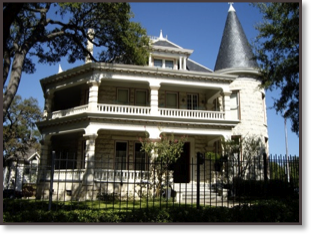Old Judges Hill Historic District
A Proposed Austin Local Historic District
Daniel Caswell House - 1899

Historic Use: Residence
Current Use: Events
National Register of Historic Places
Recorded Texas Historic Landmark
City of Austin Historic Landmark
Built for a prominent cotton merchant and civic leader circa 1899, this rusticated limestone house (4,560 square feet) was one of three imposing, adjacent mansions built by the Caswells around the turn of the century, all designed by architect A.O. Watson. The hilltop site combined views of Shoal Creek with cool breezes and easy access to downtown via the Rio Grande streetcar line. Combining Gothic, Chateauesque and Renaissance features, the 2 ½ -story house features a round turret with a conical roof. on the northeast corner of the main (east) facade. The tower contains a stairwell to the second floor. In order to include an exterior door into the stairway, the first floor of the tower was altered probably in the 1930's when the house was converted into a duplex. The elaborate frieze with festoon motif, dentils and wide eaves further decorate the tower. The steeply pitched hipped roof terminates with a flat deck surmounted by metal cresting. Gabled pavilions project from the north, south and west facades. Surrounding the remainder of the east facade is a two-story gallery which wraps around part of the south facade. One-story smooth stone columns with a scored effect support stilted arches typical of the Chateauesque. The first floor gallery is slightly taller than the second floor gallery, but each level has an entablature containing dentils, modillions and a cyma recta cornice. Combining both Gothic and Renaissance features, in the bayed pavilion on the south facade, a pointed arched Palladian window in the gable opens up the attic level. On the east facade is a large elaborate hipped roofed dormer projecting above the central bay of the house. The coupled windows of the dormer are sheltered by wide eaves with decorative modillions and an entablature supported at each corner by three columns. The main body of the house utilizes rusticated limestone with smooth stone lintels over the windows. A transom above the first floor windows enlarges the openings on the first floor. On the north facade a long narrow stained glass window capped by a round arch creates additional interest.
Significant Persons Associated with the Building
Daniel H. Caswell (1835-1916) was born in Maine and came to Austin in 1890 from Tennessee. He founded Austin Oil Manufacturing Company, a cottonseed oil mill, at 5th & Chicon, to produce cottonseed oil, cake and meal. Later he operated a cotton gin. Caswell and his sons were involved in all aspects of the cotton industry – buying and selling, processing raw cotton, and the manufacture of by-products. A daughter and her husband, Clara and P.G. Dismukes, lived in the house with her parents for several years after it was built, as did daughter Fannie and her first husband, Charles Hoyt. Matriarch Louise Broadwell Caswell continued to live in the home after her husband died until her death in 1927, when the Caswell’s eldest daughter Helen Gerhard and her husband Will, an assessor/collector and native of Nassau, Germany, moved in for a few years. Fannie and her second husband, William V. Brenizer, became owners in 1932. Having no children, the Brenizers remodeled the home into two flats. Fannie died in 1834. W.V. continued to reside on the first floor until 1965.
Judge John Edward Hickman and his wife were second-floor tenants from 1935-38; Hickman later served on the Texas Supreme Court for 25 years, presiding as Chief Justice for 12 years. The Ralph Bicklers, whose home had been demolished when 15th Street was widened, were tenants when the City took the property for a street right-of-way in 1979. The City decided not to use 15th as an expressway, and the house was sold to the Austin Junior Forum in 1968. A major restoration was undertaken. The extension of 15th Street also caused the demolition of the middle house, occupied by D. Haskell Caswell Jr.